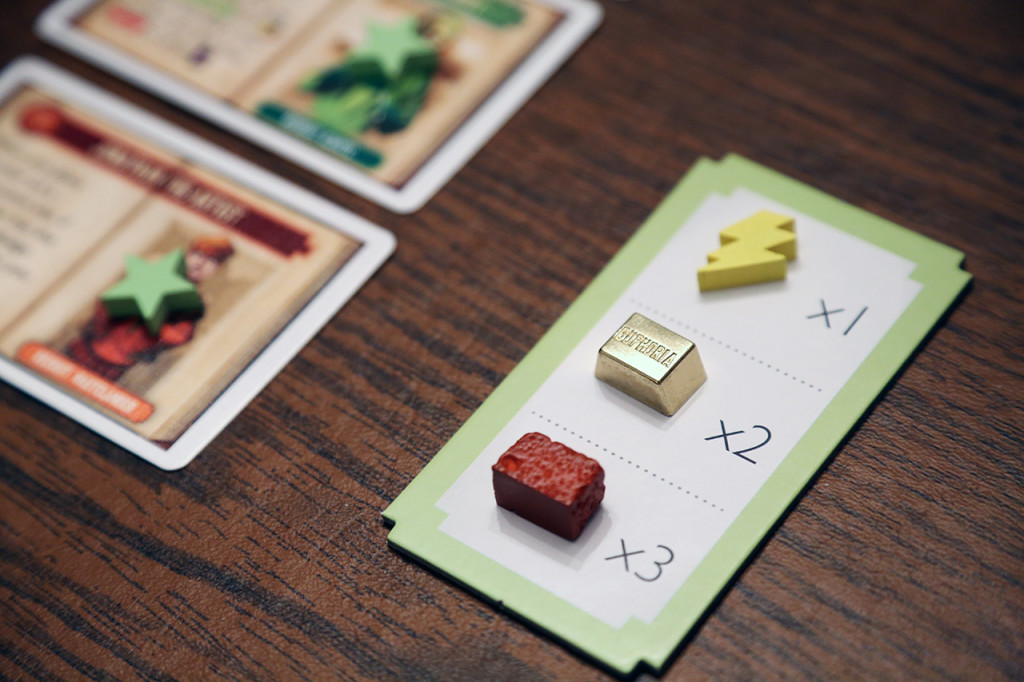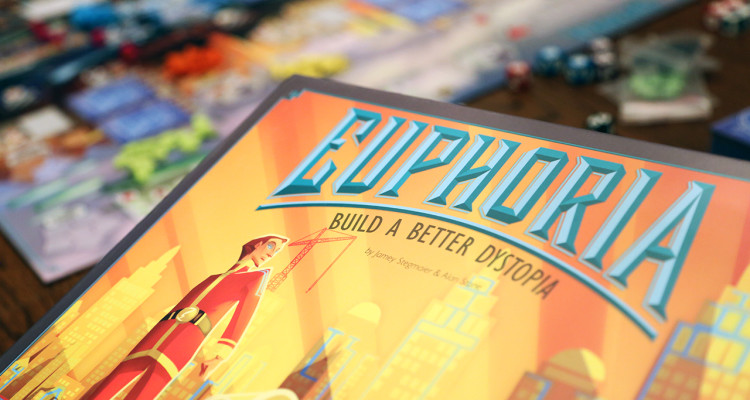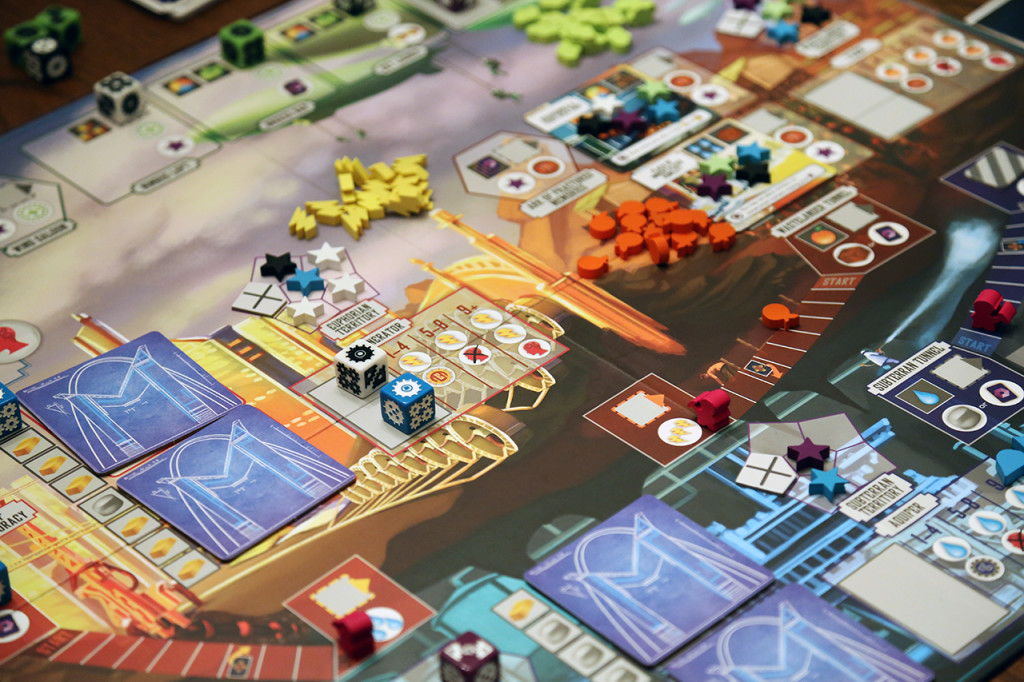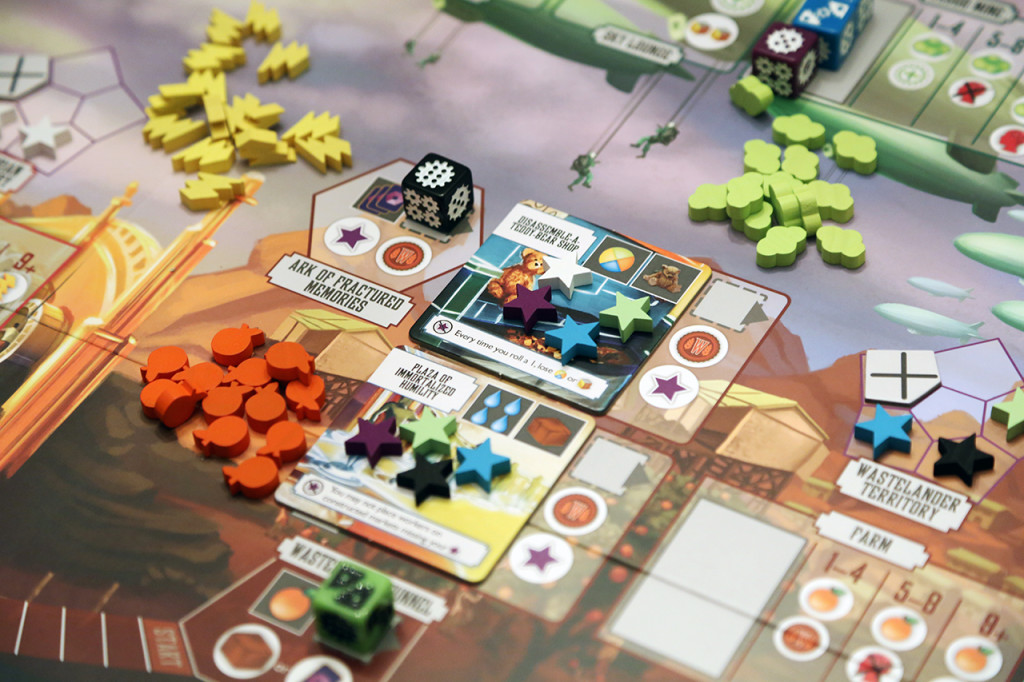Euphoria, a golden-walled city of intellectual equality, rises above the devastated wasteland of this post-apocalyptic world. From birth, you, from whom all knowledge of the past has been withheld, consider this world of yours a Utopia. Now, having discovered the truth that not everything is so rosy, what are you willing to sacrifice in order to provide a better future, and build a better Dystopia?
Design
Euphoria is a game for 2 to 6 players, designed by the same brains behind Viticulture, Jamey Stegmaier & Alan Stone, along with art by Jacqui Davis.
In Euphoria, players take on the role of a disillusioned citizen within the grand city, one with the potential drive and resources to overthrow the current Euphorian elite and restore the promise of a brighter future to this faded world. The path towards this promise comes in the form of ‘Authority Stars’ that players have the opportunity to place in each of the four territories of the board, along with several other areas when certain goals are achieved. The first player to place all ten of their stars will claim immediate victory.
As a worker-placement game, you begin this conflict with a pair of humble workers that have come to your cause, as well as two trained recruits drawn from the four factions that provide needed commodities to the city.
These four factions include:
The Wastelanders, that ragged society of farmers and historians outside the city, those who have experienced the apocalypse first-hand; they control the food. Euphorians, the misled citizens of this secrecy-shrouded city; they control the energy. Beneath them all, the hidden city of Subterra lies buried in a tangle of pipes and steam-powered gears, through which they control the much-needed water. Finally, there are the mysterious Icarites, hovering above the wasted earth in fantastic airships and tempting those below with promises of eternal bliss.
Coveting the wealth of the other factions, each of the three earthbound groups are in the midst of constructing subterranean tunnels, their completion allowing loyal workers access to the commodities of the targeted faction. Additionally, while digging through these depths, your workers have the potential to acquire the ore, gold, and stone needed to construct the various Markets throughout the city, or artifacts from the world prior, for which a high price will be paid.
Split between the three territories in the city, there are six of the aforementioned marketplaces waiting to be built, each providing, not a bonus to those players that complete them, but rather a penalty to those that did not assist in their construction. As a faction of traders, the Icarites are willing to provide your every need… for a price; they begin the game with several pre-constructed locations for trade in their territory.
When planning any potential coup, gathering the support of others with promises of future power is a tried and true method and this is represented by the Allegiance tracks for each of the four factions. By gaining their favor, and eventually their full backing, those with active recruits will receive additional rewards from the matching factions’ commodity generators and tunnel excavation sites. Hidden (face-down) recruits will join you when the track has advanced far enough, and once the faction has risen to power at the end of the track, Authority Stars may be placed on each active recruit of that faction.
Workers in Euphoria are represented with custom-molded dice in your player color, the value on those dice showing the ‘dystopian knowledge’ of that worker. If the collective knowledge of your worker pool rises too high, the one with the highest value will be discarded after discovering the terrible truth about the world. Every time a worker is returned to the pool, either through retrieval, fresh activation, or bumping by an opponent, the die is rerolled and the knowledge value of the worker changes.
Gameplay
Each player begins the game with two workers, 10 authority tokens, and are dealt four of the Recruit cards. From these, two are chosen (one face-up and considered active, the other face-down) with the remaining two being discarded. Oddly enough, this will be one of the more important choices you’ll make during the game, as each recruit is from one of the four factions and will grant a special power while active; additionally, you’ll only receive bonuses from the Allegiance track that correspond with the faction of your active recruit. One ethical dilemma card is also given to each player who may look at it before keeping the card face down.
The six available markets are chosen at random and placed face down on the featured construction sites, although there are some suggested variants where these tiles are either drafted, or a limited knowledge of the chosen pool is available. Depending on the number of players, both the available territory locations (for star placement) and the number of workers required to construct a market site are adjusted.
In the base game, all other markers for the various tracks (morale, knowledge, allegiance, and tunnels) are placed on their marked starting locations, while an advanced variant allows players to draft for positions on the morale and knowledge tracks. Each player rolls their starting worker dice, and the game begins with the player having the highest collective knowledge on their workers going first.
Player’s Turn
On a player’s turn, they may do one of the following:
- Place a worker (any available workers sharing the same knowledge value may also be placed, as a bonus.)
- Retrieve one or more workers from the board.
- Resolve Ethical Dilemma card. (Once per game)
To place a worker, set the die (face unchanged) in the chosen action space, and immediately perform the listed action. If you are placing multiple workers, do so one at a time, resolving actions before placing the next worker. If you ‘bump’ another worker off of an occupied temporary action space, return it to the owner. They must re-roll that die and check their new knowledge level.
When retrieving workers, a bliss or food commodity may be spent in order to increase the morale track by two points. If you do neither, morale will instead drop by a single point. As always, re-roll all dice that have been returned to your pool, and check for potential fugitives at this point.
Once per game, you may instead choose to resolve the Ethical Dilemma that you’re faced with. When doing so, you must flip the card over and spend the indicated type of artifact to obtain your choice of two benefits. In doing this, you may choose to either support the establishment and place an Authority Star on the dilemma card, bringing you closer to victory, or ‘fight the man’ and draw an additional face-down recruit to aid your struggle.
There are several different types of spaces available for worker placement; temporary, one-use, and multi-use locations. Temporary locations may be used even if they are occupied; any workers currently in place (even your own) are ‘bumped’ and returned to the owner’s pool before being replaced by the new worker. Bumped workers will be available for placement on the owner’s next turn. These spaces generally include the tunnels, active markets, and worker-activation locations.
One-use locations are represented by a solid border, and workers cannot be bumped out of these locations. These spots are generally reserved for the market-construction sites, where workers must stay until the market is completed in order to be counted as a contributor to the building process.
Additionally, each faction has their own multi-use location for the generation of specific commodities, and any number of workers may occupy this spot at once; the twist being that the total value of the workers placed there will modify the rewards gained. The first tier gives a single commodity and a boost on the allegiance track for that faction, the second negates one point of knowledge as well as granting one commodity, while the third gives two commodities at the penalty of one additional knowledge. These commodity spots are the easiest way to raise the allegiance of a non-Icarite faction, making this one of the few spots where the usual worker-placement tactic of ‘blocking’ will be effective.
One of the key actions in these types of games tends to be generating additional workers, and in Euphoria this is accomplished by manning the Worker Activation Tank. These new workers are thematically activated through either an electroshock process that costs energy and causes you to lose two points of knowledge (a good thing!), or for the more kind-hearted among you, a ‘soothing blast of pure water’ that requires, you guessed it, water, and adds two morale to your track. There is a limit of four workers that each player may control, and unless you like to push your luck, it’s unlikely that you’ll ever want to roll all four at once.
With the goal of Euphoria being to place your 10 authority stars on the board, there are several methods by which to do so:
- Each player that has contributed to the construction of a market (IE: Has a worker on one of the construction spaces when they’re filled) may place a maximum of one star on the newly active Market.
- When the final step on the Allegiance track is reached, players with recruits of that faction may place a star on each one that they control. (And on any new recruits featuring that faction that they happen to draw.)
- Patronize an Artifact Market
- Patronize a Constructed Market.
- Choose to ‘Support the Establishment’ through the Ethical Dilemma.
Each of the four factions have a section of territory, featuring a number of available spaces equal to the player count, that are able to be claimed throughout the game. While both artifact and constructed markets allow you to place authority stars in this territory, the former also allows you to add a star to a constructed market that you are not already present in. This also has the benefit of negating the penalty caused by the lack of participation in constructing the market.
As soon as a player places their tenth authority star, the game immediately ends. With the simultaneous authority star placement of the constructed markets or the allegiance track it is possible for a tie to occur. Ties are broken in the following order: highest morale, lowest knowledge, most markets with an authority token, most territories with at least one authority token, and finally, if it somehow comes down to it, highest die roll of all active workers until a winner can be declared.
Overall Experience
Euphoria is a beautiful game, from the almost retro-inspired board artwork to the portraits on the recruit cards, and the Kickstarter-exclusive resource upgrade provides a very tactile enjoyment to collecting the fruits of your workers’ labors. Much like the city itself, this outward charm seems to conceal several deep-seated cracks. So much of the game revolves around the initial recruit selection, that not sharing a faction majority with the rest of the players puts you on the wrong foot almost immediately.
The Icarites, an entire faction / area of the board that was added as a stretch goal during the Kickstarter campaign, can be especially frustrating in this fashion. With their 2nd-tier allegiance-track bonus, an Icarite player can gain three cards (the price of an Authority Star at an artifact market!) on a single action. [A sharp-eyed reader notified us that we did indeed get a rule wrong. The 2nd tier allegiance bonus only applies when placing an authority star in Icarite territory. We’ll be revising this section after a few more plays. – Ed]
As each of the trading actions provides an increase in allegiance from the start of the game, as opposed to the other factions’ easily-sabotaged commodity generators, the Icarites will generally have an easier-than-usual rise along their track, culminating in the all-important authority star at the end. Of course, none of this would be that big of an issue if it weren’t for the bumping mechanic.
The rule that you can bump your own workers off a spot and take the action again is perhaps the item that mechanically bothers me the most. When choosing to bump an opposing player from a spot, you have to take into account the extra turn it gives them before they have to take the time to retrieve their workers; when bumping your own worker, it’s nothing but a bonus. There is a single constructed market with the penalty of being unable to bump your own workers, but opportunities for it to come into play are few and far between.
Finally, there’s the random nature of your worker values that I have to take issue with. If this is supposed to represent your ‘dystopian knowledge’, why does it change every time a worker returns to the pool? I believe that I would have been much happier with the ‘lose a worker if your knowledge is too high’ mechanic if the dice values were fixed, and the recruit powers and board spaces affected them instead of your nebulous ‘knowledge track’. It would both fit the theme much more effectively, and make available another layer of planning, while avoiding sudden random swings. (“What do you mean I only have one worker now, because I rolled double sixes on the third turn of the game?”)
Of course, not everything can be doom and gloom, so take a moment to read the rulings of the other League members that enjoyed this game far more so then I.
League Rulings
Smee’s Two Pence
This game has produced perhaps the most polarized reaction among the League so far to date, with two hailing it as the best thing since industrialized farming, and another two, myself included, likely needing a bit of cajoling to allow it back on the table. The rest of my two pence (and likely more!) is available in the ‘Final Thoughts’ section above, so the only thing left to take care of is my rating. While not a poor game, I feel that so much more could have been done with it, and Euphoria gets a solid zero thumbs in the medium worker-placement category, unfortunately.
Buns
Within a highly competitive game group, it can often be difficult for me to separate the bitterness of a loss from my opinion of a game overall. When a game hits the table that provides enjoyment not associated with my performance, I take special note. In the case of Euphoria, even as I bumbled through a late-night 5-player game, I found myself having a significant amount of fun. I was initially put off by the game, as it is not nearly as organized and approachable as some other worker placement games I have played. The sheer wealth of options and the little direction provided left me with zero strategic plans, so I just went through the motions. When all was said and done, I was not a winner, but I was hooked.
Through a combination of wonderful theme, beautiful components, and engaging gameplay, Euphoria has become one of my favorite worker placement games. As a fan of all things dystopian, the allusions to classic sci-fi texts and a layer of subtle macabre makes Euphoria hit home for me, much more than the common agrarian and manufacturing based themes of its competitors. As a whole, the concept of this game is something I adore, which is a large influence on why I find it so engaging. I enjoy picturing the happenings of the city, and chuckling to myself as I “awaken” a new worker or pacify my citizens with laced food and “Bliss.”
Pulling away this polished exterior reveals a game that functions like many that have come before it, though a few additions make it unique. Dice-based WP games have been done; the most notable are Euphoria’s cousins Alien Frontiers and Kingsburg. All three fall prone to the same problem – randomness. This takes some of the decision making out of the player’s hands and forces you to work towards mitigating the dice rolls. Euphoria tacks on the “knowledge” track, meaning that your workers may up and leave mid-game, leaving you at a disadvantage. These elements mean that your dice must be considered and managed diligently if you want to optimize your moves.
Recruits and markets are the other major players here, as they can often provide a win-condition. I highly suggest drafting both of these because having some control over these elements will likely make for a more enjoyable experience. We have yet to truly sink into these variants, but I do feel that Euphoria provides enough options to soften, if not completely nullify, many of the problems that may arise.
To stem the flow of thought here, I’ll end with the simple fact that Euphoria is enjoyable. There are chinks in its glossy exterior, but I like many of the small tweaks that the designers have added to this often cookie-cutter genre, and see it as comparable to its competitors, if not superior. With Grade A production value and engaging gameplay, Euphoria is a welcome addition to my game collection.
Ben
The first time Euphoria was being set up and as the rules were being explained, I was wondering what I was getting myself into. This is my typical response to Euro and worker-placement games that have a lot going on with a lot of decisions to be made. However, I really started to have fun playing this game with the dystopian theme adding some nice flavor. One of the things that I think helped secure my love for this game is the fact that you really can’t be blocked from taking an action. Worker-placement games that allow for actions to be blocked usually end up aggravating me. In these types of games, I like to be able to implement the strategy that I’m going with and just play it out to see whose approach worked the best. For that reason, I appreciated the “bumping” mechanic. It allows you to take an action if you really need to, with the penalty of giving your opponent an extra action, but it also played into my strategy. In certain times, I could have a feel for what people needed and use a “bumpable” action space in the hope of being bumped off and gaining another action.
Euphoria also offers a decent amount of replayability. With the wealth of choices available to you there are multiple routes to victory and you could try a different method each time you play. In one game you may completely ignore the Subterran Territory, while the next game you may try to be more diverse and do a little of everything.
Some of the League members have found flaws to the game. In the end though, Euphoria has become one of my favorite worker-placement games. From the chunky dice and other quality components to the fun, dystopian theme, I enjoyed Euphoria and would recommend it to others.









